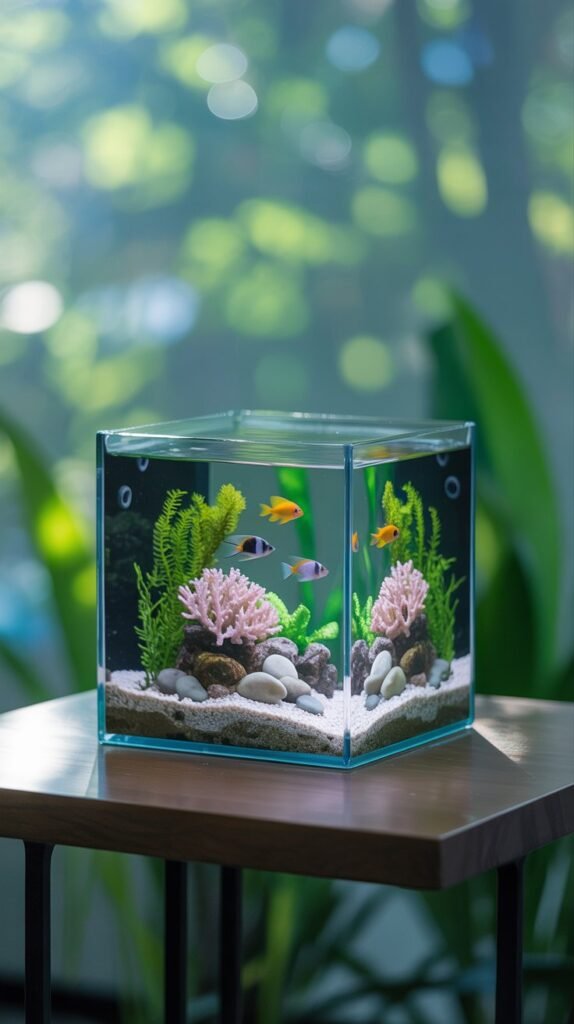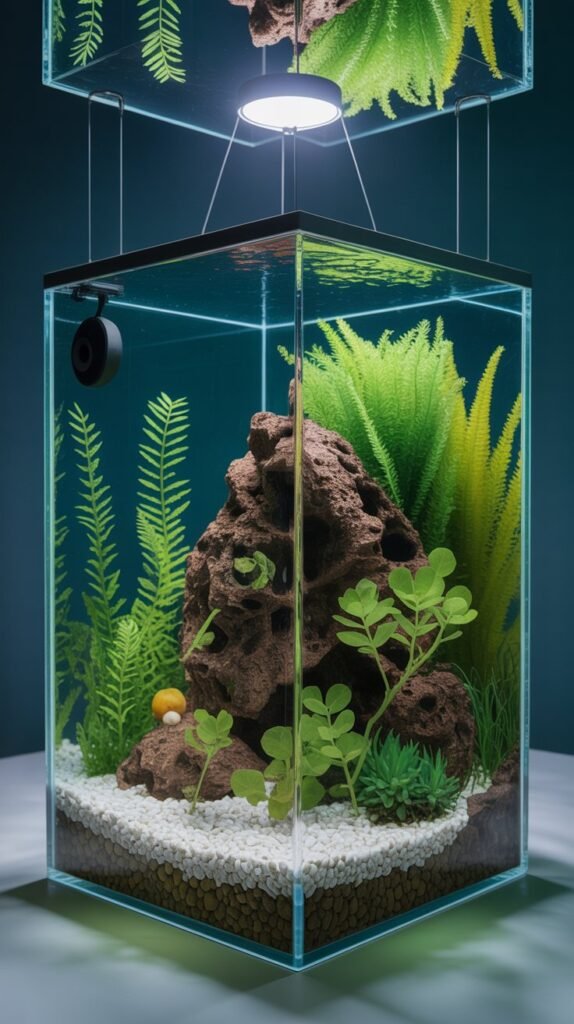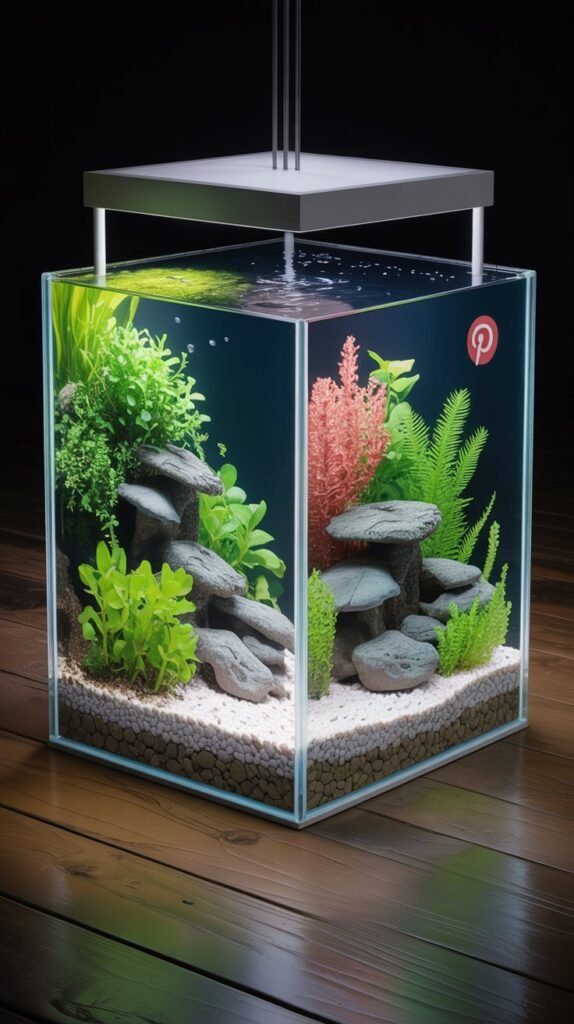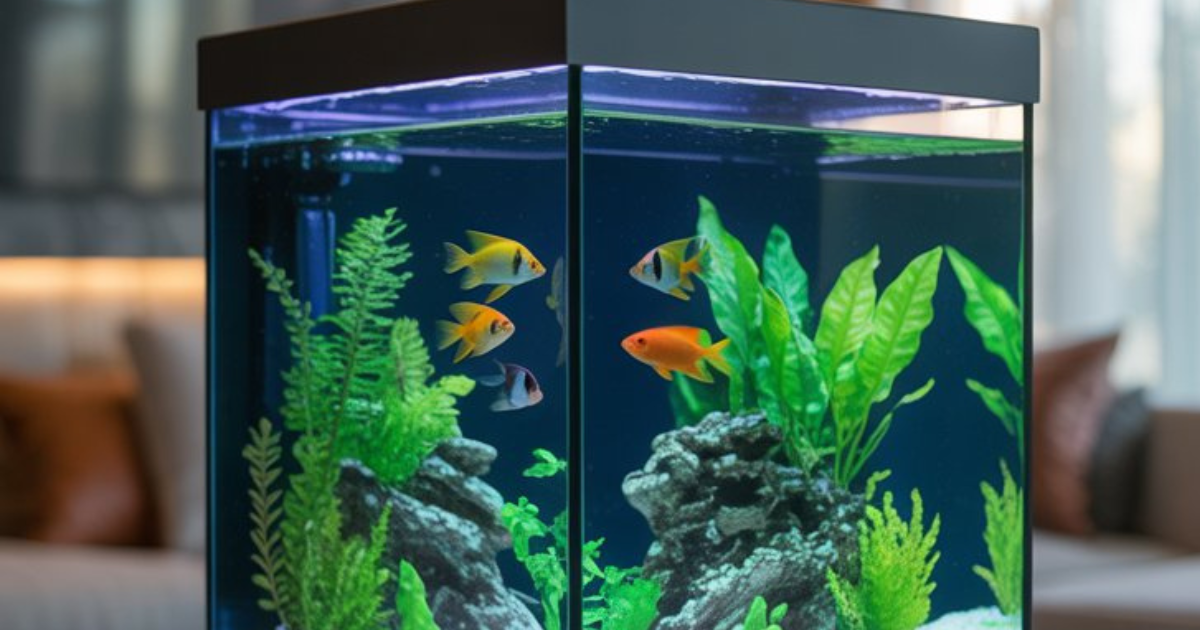Aquariums have always been a blend of science, art, and relaxation. From massive rectangular display tanks to tiny nano setups, fishkeepers have a wide variety of styles to choose from. Among these, the cube aquarium stands out as one of the most versatile and aesthetically appealing designs. With its balanced dimensions and modern look, a cube aquarium is perfect for both beginners and advanced aquarists who want a unique way to showcase aquatic life.
In this comprehensive guide, we’ll dive deep into everything you need to know about cube aquariums, including their features, advantages, disadvantages, setup process, aquascaping ideas, and maintenance tips. By the end, you’ll know whether a cube aquarium is the right choice for your fishkeeping journey.
What is a Cube Aquarium?
A cube aquarium is an aquarium with equal or nearly equal length, width, and height dimensions, giving it a square, cube-like shape. Unlike traditional rectangular aquariums, which are long and shallow, cube tanks are compact and balanced, making them ideal for smaller spaces or as stylish centerpieces.

Cube aquariums are often used for nano aquascapes, shrimp colonies, betta setups, and designer aquariums. They are available in a wide range of sizes, from tiny 2-gallon nano cubes to larger 50-gallon cube aquariums.
Why Choose a Cube Aquarium?
Cube aquariums have gained popularity among modern aquarists for several reasons:
- Space-Saving Design – Cube aquariums are compact and can fit on desks, counters, or small tables without taking up too much space.
- Modern Aesthetic – Their symmetrical, minimalist design makes them look like living works of art.
- Unique Viewing Angles – With equal dimensions, cube tanks provide excellent 360-degree viewing when placed strategically.
- Perfect for Aquascaping – Cube tanks highlight vertical scapes such as rock pillars, driftwood towers, and planted layouts beautifully.
- Beginner-Friendly – Many cube aquariums come in all-in-one kits with built-in filters and lighting, making them ideal for beginners.
Cube Aquarium vs. Rectangular Aquarium
Let’s compare the cube aquarium to the traditional rectangular aquarium to better understand the differences:
| Feature | Cube Aquarium | Rectangular Aquarium |
|---|---|---|
| Shape | Equal or nearly equal dimensions | Long and shallow |
| Design | Compact, modern, stylish | Traditional, practical |
| Viewing | 360-degree, immersive | Wide, panoramic |
| Aquascaping | Vertical, depth-focused layouts | Horizontal layouts |
| Best For | Small spaces, stylish displays | Large communities, breeding setups |
| Price | Usually higher per gallon | More affordable for large tanks |
Benefits of a Cube Aquarium

1. Space Efficiency
Cube aquariums maximize volume while occupying a small footprint, making them ideal for apartments, offices, or small living spaces.
2. Stylish Display
Their symmetrical design makes them look more like an art piece than just a fish tank. They often blend seamlessly into modern home décor.
3. Unique Aquascaping Potential
Unlike long tanks, cube aquariums encourage vertical aquascaping, such as tall plants, rock pillars, or driftwood structures that emphasize height.
4. Versatility
Cube tanks can be used for a variety of setups, including freshwater planted tanks, saltwater reef tanks, nano shrimp colonies, or even single betta displays.
5. Perfect for Beginners
Smaller cube tanks often come as plug-and-play aquarium kits, making setup and maintenance easy for new hobbyists.
Drawbacks of a Cube Aquarium
While cube aquariums have many benefits, they also come with a few downsides:
- Limited Stocking Options – Smaller cubes cannot house large or active fish species.
- Maintenance Challenges – Nano cube aquariums (under 10 gallons) require frequent water changes due to limited water volume.
- Lighting Distribution – Because cube tanks are deeper than they are wide, strong lighting may be necessary for bottom plants.
- Higher Cost per Gallon – Cube tanks are often pricier compared to rectangular tanks of the same volume.
Types of Cube Aquariums
Cube aquariums come in several variations, depending on size, material, and purpose:
- Nano Cube Aquariums (2–10 gallons) – Small tanks perfect for desktops, shrimp colonies, or bettas.
- Medium Cube Tanks (15–30 gallons) – Great for aquascaping and small communities.
- Large Cube Aquariums (40–60 gallons or more) – Stunning centerpieces that can house larger aquascapes or reef systems.
- Glass Cube Aquariums – Standard, clear, and elegant, often made from low-iron glass for crystal clarity.
- Acrylic Cube Aquariums – Lighter than glass, scratch-resistant, and available in larger custom sizes.
- All-in-One Cube Aquariums – Kits that come with built-in filtration, lighting, and sometimes heaters, designed for beginners.
Setting Up a Cube Aquarium

A cube aquarium setup requires planning to maximize both aesthetics and fish health. Here’s a step-by-step guide:
Step 1: Choose the Right Stand
Cube aquariums need a flat, level stand that can support their weight. Since cube tanks concentrate weight in a smaller footprint, stability is essential.
Step 2: Plan the Aquascape
Use vertical elements like tall plants, driftwood, and rock formations to take advantage of the cube’s depth. Keep in mind the rule of thirds for balanced design.
Step 3: Install Equipment
- Filter – Canister filters or internal filters work best for cube aquariums.
- Heater – A submersible heater ensures stable temperature.
- Lighting – Strong LED lights are essential, especially for taller cube tanks where light penetration is critical.
- CO2 System – For planted cube aquascapes, CO2 injection boosts plant growth.
Step 4: Add Substrate and Hardscape
Choose substrate (sand, gravel, or aqua soil) depending on your setup. Place hardscape elements like rocks and driftwood first before planting.
Step 5: Fill and Cycle the Tank
Fill the tank slowly with dechlorinated water and allow it to cycle for 4–6 weeks to establish beneficial bacteria before adding fish.
Step 6: Introduce Fish and Plants
Gradually add your chosen fish and plants once the cycle is complete. Avoid overstocking, especially in nano cubes.
Maintenance of a Cube Aquarium
Like any aquarium, cube tanks require regular maintenance. Here are key tips:
- Weekly Water Changes – Replace 20–30% of water weekly to maintain water quality.
- Filter Maintenance – Clean filter media every 2–4 weeks to prevent clogging.
- Glass Cleaning – Use an aquarium-safe scraper to clean algae from all sides.
- Monitor Parameters – Regularly test water for ammonia, nitrite, nitrate, and pH.
- Trim Plants – Keep plants trimmed and healthy for a neat aquascape.
Best Fish for Cube Aquariums
Cube aquariums are perfect for small, colorful, and peaceful species. Some great options include:
For Nano Cube Aquariums:
- Betta Fish
- Guppies
- Endler’s Livebearers
- Neon Tetras
- Cherry Shrimp
- Nerite Snails
For Medium Cube Aquariums:
- Dwarf Gouramis
- Harlequin Rasboras
- Zebra Danios
- Corydoras Catfish
- Amano Shrimp
For Large Cube Aquariums:
- Angelfish
- Discus
- Larger Tetra Schools
- Small Reef Fish (Clownfish, Gobies, etc.)
Aquascaping Ideas for Cube Aquariums
Because of their depth and symmetry, cube aquariums lend themselves well to creative aquascaping. Some popular styles include:
- Iwagumi Style – Rock-based minimalist layout with carefully placed stones and carpeting plants.
- Dutch Style – Colorful plant-focused scapes with layered vegetation.
- Jungle Style – A natural, wild look with tall plants and driftwood.
- Shrimp Colony Tank – Nano cube filled with mosses and shrimp.
- Reef Cube – A marine setup featuring corals, live rock, and reef fish.
Tips for Buying a Cube Aquarium
- Check Glass Quality – Go for low-iron glass for clear viewing.
- Choose the Right Size – Match the size of the tank to your space and fish choice.
- Consider All-in-One Kits – Beginners benefit from cube aquarium kits with built-in filters and lights.
- Ensure Stand Compatibility – A cube tank must sit on a strong, level stand.
- Think About Aquascaping Goals – Select a cube that matches your desired layout style.
Cube Aquarium for Freshwater vs. Saltwater
- Freshwater Cubes: Ideal for planted aquascapes, shrimp setups, and small fish communities.
- Saltwater Cubes: Perfect for reef setups, clownfish pairs, and nano marine communities.
Both setups are possible, but saltwater cubes require more advanced filtration and lighting systems.
Conclusion
A cube aquarium is more than just a tank—it’s a stylish, compact, and versatile piece of aquatic art. Whether you’re a beginner looking for a small nano setup or an experienced aquarist planning a lush planted scape or reef system, a cube aquarium offers endless possibilities.
With their modern look, unique aquascaping potential, and wide range of sizes, cube aquariums are a perfect choice for anyone who wants to combine fishkeeping with interior design. While they may come with some challenges like limited stocking and lighting considerations, the beauty they bring to your space makes them well worth the investment.
FAQs About Cube Aquariums
Q1: Are cube aquariums good for beginners?
Yes, many cube aquariums come as all-in-one kits with built-in filters and lights, making them beginner-friendly.
Q2: What size cube aquarium should I start with?
A 10–20 gallon cube is a great starting size for beginners—big enough for stable water conditions but small enough to manage easily.
Q3: Can I keep a betta in a cube aquarium?
Absolutely! A 5–10 gallon cube is perfect for a betta fish, especially if decorated with live plants.
Q4: Are cube aquariums more expensive than rectangular ones?
Generally, yes. Cube aquariums cost more per gallon due to specialized glass cutting and design.
Q5: Can I use a cube aquarium for saltwater?
Yes, cube aquariums work well for nano reef tanks and small marine setups, provided you use the right equipment.
Q6: Do cube aquariums need special lighting?
Since cube tanks are deeper than long tanks, you may need stronger LED lighting to ensure proper light penetration for plants and corals.
Q7: What’s the biggest cube aquarium available?
Custom cube aquariums can exceed 100 gallons, but most commercially available ones range from 2 gallons to 60 gallons.

